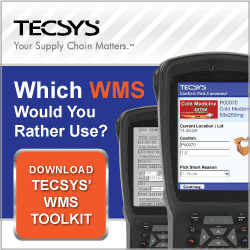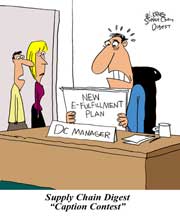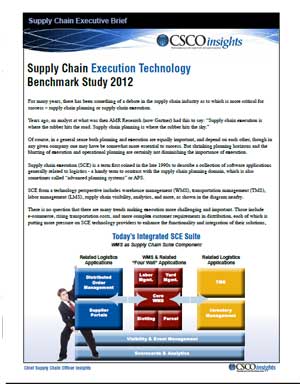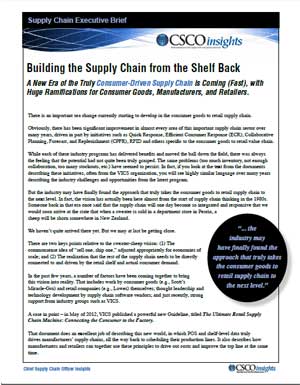 |
November 15, 2012 - Supply Chain Newsletter |
 |
FEATURED SPONSOR - TECSYS |
 |
Which WMS Would You Rather Use?
|
 |
|
||||||||||||||||||||||||||||||||||||||||
The Political Supply Chain
|
|||||||||||||||||||||||||||||||||||||||||
| GILMORE SAYS: |
"A change in these rules (again, coming from regulation not legislation) could also cause tens of thousands of independent truck drivers to fall under its effect, meaning they could be forced to join the Teamsters union." WHAT DO YOU SAY? |
I try very hard to be apolitical in making such observations, but will say I am offering them based on being in business in one way or the other for 25 years (i.e., I am generally pro-business), and in terms of what is good or not for the supply chain. In other words, some may think (just as an example) that raising taxes on diesel fuel is a good thing because we need to increase funds available for infrastructure improvements and/or force truckers to pay the true social costs of the transportation industry. I am not here today to sort that out. Raising diesel fuel taxes would increase logistics costs, and so my point of view would be from that perspective.
I hope that is clear.
The most notable thing in general is that the status quo of the last two years has not changed. Democrat Obama is still in the White House, and the Democrats control the Senate. Critically, however, the Republicans of course still control the House.
This means that many potential legislative proposals that some may see as anti-business or negative for the supply chain are highly unlikely to become law.
However, the Obama administration has arguably taken what is in effect law making through regulations to levels never seen before, and this is where there are risks to business and supply chain interests.
To me, the by far most likely scenario is the National Labor Relations Board will try to approve some form of "card check" rule. Card check is the term used to describe a proposal in which unions could be formed not through majority vote in a secret election, but through having a majority of workers sign a "card" saying they are for the union.
The obvious worry of business interests is the way more union pressure could be applied in this now public process. The union forces would know exactly who has signed the card and who hasn't.
This idea, which was passed in a bill by the then Democratically controlled House in 2007 but which later failed in the Senate, was the number 1 priority of labor forces, who of course supported Obama tremendously with votes, dollars and effort in 2008 and now 2012. That the bill couldn't get it through with the Democrats controlling the presidency, House and Senate in 200708 was a very sore point for them.
It looked likely back then it would pass, and that had many areas of the supply chain, especially retail distribution, quite worried. But when the Republicans took back the House in 2010 and have now kept it in 2012, there is zero chance of this legislation passing in the next two years.
 But it still could become law if the very aggressive NLRB, which tried to close down an almost completed Boeing factory in South Carolina over a bizarre union issue, and approved rules that would allow rapid, "microwave" or "ambush" union votes (strangely to me this is still tied up in the courts), decides to take matters into its own hands. And that is a real threat. Whether it has the authority or not to do so is unclear, but the NLRB may act first and worry about the consequences later, with Obama no longer worried about re-election and union leaders looking for a return on their investment.
But it still could become law if the very aggressive NLRB, which tried to close down an almost completed Boeing factory in South Carolina over a bizarre union issue, and approved rules that would allow rapid, "microwave" or "ambush" union votes (strangely to me this is still tied up in the courts), decides to take matters into its own hands. And that is a real threat. Whether it has the authority or not to do so is unclear, but the NLRB may act first and worry about the consequences later, with Obama no longer worried about re-election and union leaders looking for a return on their investment.
Similar story with regards to "cap and trade" laws that would put a real cost to carbon emissions. California's cap and trade program is just now starting up in earnest, but obviously we have nothing on a national level. With a Republican Congress, nothing will happen on Capita Hill for at least the next two years.
But in a momentous case in 2007, the Supreme Court ruled that the EPA could issue regulations regarding greenhouse gas emissions under the Clean Air Act, after the EPA determined that GHGs were a danger to public health. That decision was in essence upheld in June of this year.
That has led to new EPA rules relative to greenhouse gas emissions for manufacturers and utilities, including regulations that in effect ensure no new coal fired power plants will ever be built in the US again. It's no surprise once reliably Democratic West Virginia went for Romney.
So those are the two biggies for me. What are the chances for these regulatory moves? I have to say at least 50%, with a somewhat higher probability relative to card check, but that would cause a fierce business pushback. I suspect the EPA will do something more to reduce carbon emissions, but perhaps stop short of a full cap and trade program, which is highly complex. Carbon taxes are much easier.
What the US commits to if anything at the upcoming UN climate conference for 2012 will be interesting, but any treaty would have to get through the Senate, which the Democrats control but not in filibuster proof fashion.
Other issues:
Hours of Service Rules: The changes made to the rules by the Federal Motor Carrier Safety Administration and approved in late 2011 to go in effect in July of 2013 are considered onerous and ineffective by most of the logistics complex. Had the Republicans won, there might have been some move to roll the upcoming rules back. Not now.
Though the most dreaded "10 hour rule" was not part of the final changes, FMCSA administrator Anne Ferro has said that may be reconsidered in the future. I say the chances of that are good sometime before the end of the next four years. My friend Mike Regan of TranZact Technologies, who knows a lot about all this, disagrees with me on that.
Contract Employees as Union Members: Regan also pointed me towards another issue, which I haven't followed much. That is, efforts to have independent contractors classified as employees, at least in the transportation sector. This has its roots in a long-standing battle between UPS and FedEx, in which FedEx's local delivery agents are largely contactors and thus not able to form/join a union.
If it was just a jousting match between the two shipping giants it wouldn't be a large concern for shippers, but a change in these rules (again, coming from regulation not legislation) could also cause tens of thousands of independent truck drivers to fall under its effect, meaning they could be forced to join the Teamsters union.
Regan tells me fighting this change is the publicly announced number 1 priority of the folks at the Owner-Operator Independent Drivers Association (OOIDA). What's the point of being an independent if you have to join the union?
Natural Gas Trucks: If the Republicans had won, there would have been little obstacles thrown in the way of natural gas trucks and continued development of US natural gas resources through newer drilling techniques.
As I have said many times, I firmly believe such a change will be transformative to our economy and deliver substantial economic growth.
Though there have been proposals to offer subsidies of sorts to accelerate the move to nat gas powered trucks (and in my opinion eventually cars), this will happen, and I think soon, without them. Unless... the government throws up road blocks, because it would rather see electric cars, or power plants and factories running on wind and solar power than natural gas.
I don't think this change can really be stopped, but that is a less sure thing than if Romney had won. (More on this soon.)
Cost of Obamacare: Whether you like it or not, with the election, as House Speaker John Boehner said, Obamacare is really now the law of the land. There will be real, quantifiable cost to many businesses. Surely, this will provide an incentive for companies to do more outsourcing of supply chain functions (let the 3PL deal with it), especially to offshore sources that don't have to deal with it at all.
How could it not? The cost equation will simply change. There is no disputing that. Will this lead to calls for a "health insurance tariff" on some imported goods?
China and Trade Policy: That is the real wild card.
There's more, but I am out of space.
What's your reaction to Gilmore's Political Supply Chain perspective? Do you disagree? What would you add? Let us know your thoughts at the Feedback button below.
![]()
| View Web/Printable Version of this Page |
|
|
|
YOUR FEEDBACK
Trying to catch up on the many feedbacks we received. This week, our Feedback of the week goes to Arun Kumar Ojha of Schlumberger, who says that the growing use of temporary labor in US factories is not surprising, given US manufacturers haven't worked smart enough to keep themselves competitive globally.
We also have several letters relative to Dan Gilmore's First Thoughts column on Taming the Long Tail.
Feedback of the Week: On Increased Use of Temp Labor
With increase in temporary labour in manufacturing system, it brings more flexibility in scalability but at the same time it brings in lower accountability to individuals. One need to look at the business requirements in detail and deploy temporary labors in the system. US manufacturing organizations have been traditionally bulkier without performance based incentives, which has resulted in becoming less cost competitive. On top of that, the US kept believing on buying of low cost country like China, instead of focussing on bringing in efficiency, lowering cost structure, improving productivity, and bringing flexibility in supply chain in manufacturing sectors. It is too late to revive the manufacturing sector now in US. The organizations need to think all corners to bring overall cost down to be more competitive in today's economic scenario. Temporary labour is just fragment of this process.
Arun Kumar Ojha Asia Global SourcingSchlumberger |
||
| Feedback on Taming the Long Tail | ||
Thanks for covering this topic. I look forward to hearing more details on your approach to this issue. While your article was around retail inventory, I feel that the approach you use to model will probably be ok for my spare parts inventory. We segment our inventory in many layers but I'm always looking for better approaches for the "quantity and frequency of demand". Ron Whitlock
|
||
The long tail can be divided into two pieces: • Low volume /low variability (the "Steady Eddies") Each can and should be treated differently. High variability leads itself to producing to demand while the low variability can easily be forecast. Many CPG companies have taken this one step further... adding production capacity, they have utilized produce-to-demand in both high volume / low variability products and high volume/high variability products. One of our clients has pushed their "A" item inventory to 3 days supply - and their biggest clients are this you would identify as ultimately demanding.
|
||
Amazon is doing a pretty good job with their long tail strategy - but, they have vulnerabilities. Richard J Sherman, president & CEO |
SUPPLY CHAIN TRIVIA ANSWER
Q: The current largest ocean container ship assail today can carry about how many TEU (twenty-foot equivalents)?
A: 18,000, which is the capacity of the Maersk Triple E vessels. Whether it can go higher from here is anyone's guess.
| © SupplyChainDigest™ 2003-2012. All Rights Reserved. SupplyChainDigest PO Box 714 Springboro, Ohio 45066 |
POWERED BY: XDIMENSION
|








